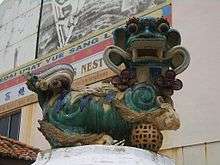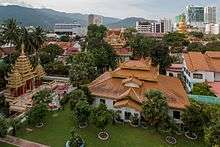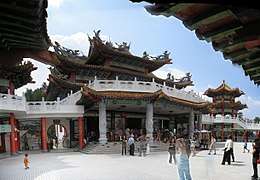Cheng Hoon Teng
Coordinates: 2°11′50.9″N 102°14′48.7″E / 2.197472°N 102.246861°E



The Cheng Hoon Teng temple (Chinese: 青云亭; Pe̍h-ōe-jī: Tshinn-hûn-tîng; lit. "Temple of Green Cloud"[1]) is a Chinese temple practicing the Three Doctrinal Systems of Taoism, Confucianism, and Buddhism located at No. 25 Jalan Tokong, Malacca City, Malaysia. It is the oldest functioning temple in Malaysia. [2]
Overview
The Cheng Hoon Teng temple is situated close to Jalan Tukang Emas, also known as "Harmony Street" because of its proximity to the Kampung Kling Mosque and Sri Poyatha Moorthi Temple.
The richly decorated Cheng Hoon Teng temple covers an area of 4,600 m2.
Featuring a magnificent main gate along Jalan Tokong, the Cheng Hoon Teng temple consists of a complex of several prayer halls, with a large main prayer hall dedicated to the goddess of mercy, Kuan Yin. Additional smaller prayer quarters were added later. One of these is dedicated to the Buddhist gods of wealth, longevity and propagation, while another houses ancestral tablets.
One of the most dramatic features of Cheng Hoon Teng temple is the seven-metre red flag-pole facing the left wing of the main prayer hall, which houses the remains of two of the three Kapitans who contributed to the construction of the temple. Across the road is a traditional opera theatre, which forms a part of the Cheng Hoon Teng temple complex.
The building conforms to the principles of feng shui. The complex is laid out to ensure a view of the river and high ground on either side.
History
The temple has a long history of association with the Kapitans China of Malacca, who headed the governance of the local Chinese community. Built in 1673[3] by Kapitan Lee Wei King with building materials imported from China, Cheng Hoon Teng served as the main place of worship for the local Hoklo (Hokkien) community. The main hall was built by Kapitan Chan Ki Lock in 1704. A rebuilding programme in 1801 contributed to the aesthetic and magnificent structural additions of the building, and was undertaken under the patronage of Kapitan China Choa Su Cheong, father of Choa Chong Long, first Kapitan China of Singapore.
In 1962, then abbot Seck Kim Seng ordained Houn Jiyu-Kennett, a Zen nun from England and the future founder of the Order of Buddhist Contemplatives, at this temple.
In 2003, Cheng Hoon Teng was awarded a UNESCO award for outstanding architectural restoration.[1]
See also
References
- 1 2 UNESCO Asia-Pacific Heritage Awards for Culture Heritage Conservation - Cheng Hoon Teng Main Temple
- ↑ http://chenghoontengtemple.com/demo/index.php?option=com_content&view=article&id=9%5Bpermanent+dead+link%5D
- ↑ https://books.google.com.my/books?id=u4_4DAAAQBAJ&pg=PA133&lpg=PA133&dq=cheng+hoon+teng+temple+inscription+was+built+on&source=bl&ots=EoQLCn9Q6O&sig=rFSKzF5ecpPabF8bA41LKwV1f1U&hl=en&sa=X&ved=2ahUKEwj_k7-l2PDcAhUBfysKHT21BJo4ChDoATAJegQIAhAB#v=onepage&q=cheng%20hoon%20teng%20temple%20inscription%20was%20built%20on&f=false
External links
| Wikimedia Commons has media related to Cheng Hoon Teng Temple. |


%2C_Sentul%2C_Kuala_Lumpur.jpg)
